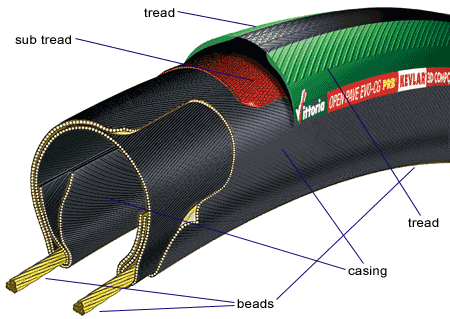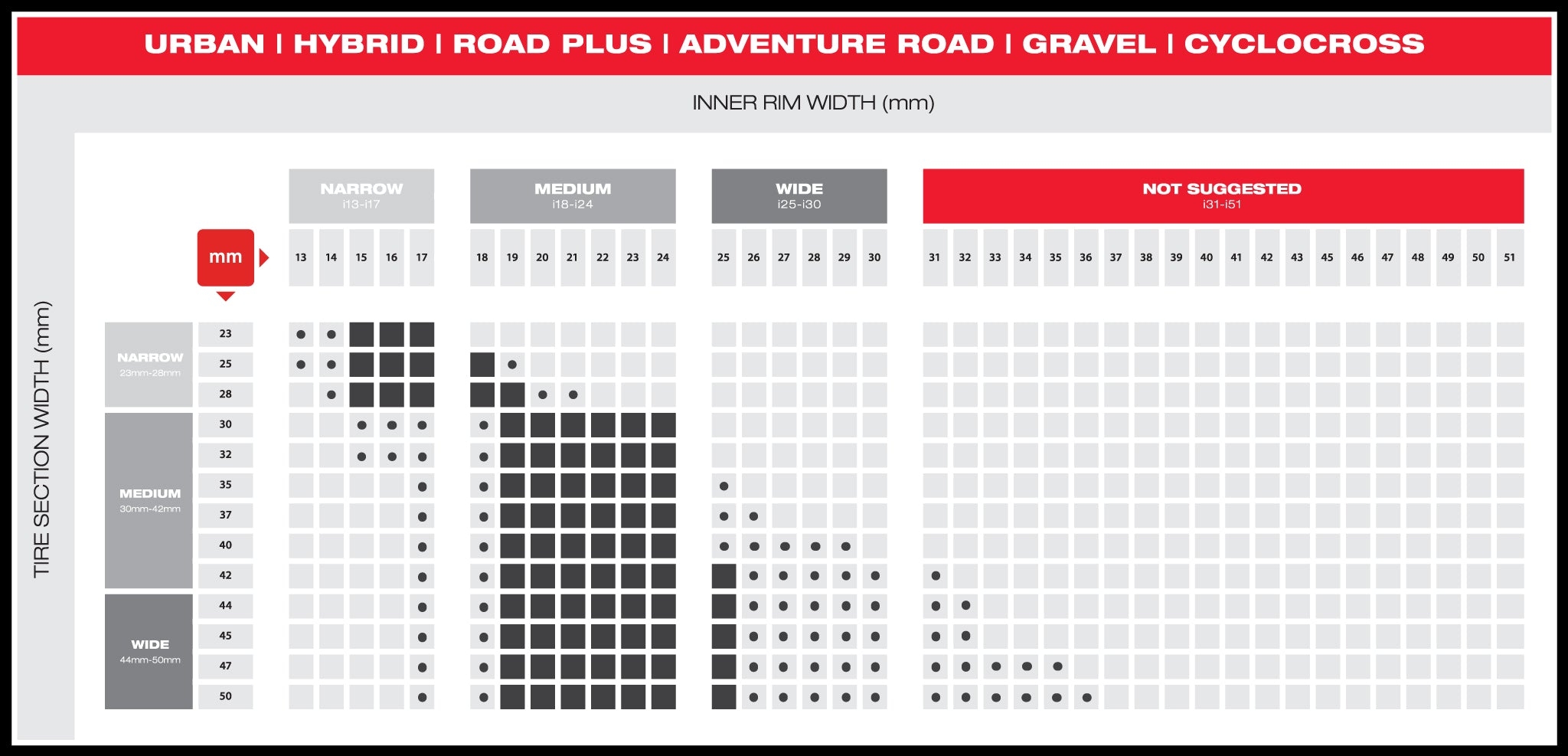Here’s the bike I have: https://www.bikesdirect.com/products/motobecane/mirage_tour.htm
Here’s the tires I want: https://www.amazon.com/gp/product/B0B6BXF43T/ref=ox_sc_act_title_2?smid=A3QGN5CVWB8NQ6&psc=1
I recently moved and there’s less paved trails and more rail trails. I want a wider tire, but can’t figure out if it will fit on the rim, within the fork/frame, or within the brake pads. I measured and 38mm looks like it should fit, but I figured someone else might know more than me. All the products and stats are listed on the site.
Also: I get it, it’s not the best bike/tire combo on the market. Cycling is only really a side hobby for me, so don’t shame my choices. I love my bike and the price I paid for it.
Other commenters addressed some of the possible clearance issues, where a wider tire might interfere with the frame. But it seems to me that the discussion on tire/rim compatibility can be fleshed out.
To lay some background, a bicycle tire is essentially mostly a hollow rubber donut, but with the inward-facing “donut hole” walls supported instead by a pair of co-axial steel hoops, known as the beads. Thus, the beads define the inner diameter of the tire. When a tire is inflated, the air pressure will cause expansion in all directions. The tire’s beads and walls (ie casing) will hold their shape, but the air pressure will try to push the two beads apart. This is where the rim walls come into play: the rim walls prevent the beads from widening apart. With the air pressure fully contained in all directions, the wheel assembly can now support impressive loads relative to the weight of the rubber and metal.

So for a bicycle rim and bicycle tire to be compatible, the two most basic criteria must be met:
- the tire’s bead diameter must exactly match the rim’s “seated” diameter, ie at the bottom of the rim walls
- the beads must fit within the rim walls, being neither too narrow or too wide, such that the tire maintains its correct shape and that normal loads will not cause the beads to slip out of the rim walls
The first criteria is a strict match, so that’s easy to check. But the second criteria has some allowance for different tire widths on a given rim, or different rims for a given tire width. We can now look at what rims you have, and whether they’re compatible with your preferred tires.
It looks like your rims are Weinmann DP18 rims, which have a trade diameter of 700C and the narrowest part of the rim walls are 12.40 mm apart. I say “trade diameter” because no part of the rim actually measures 700 mm. Instead, rim/tire compatibility can only reliably be calculated using the ISO/ETRTO measurements, which are a pair of numbers that directly answer the two compatibility criteria from earlier.
The first number in the ETRTO system is the inner rim width, and the second number is the bead seat diameter, both in millimeters. So your rims would be universally identified as 12-622 or 13-622, since 622 mm is the actual circumference if you put a tape measure around the rim. The first number can be 12 or 13 because 12.40 mm could round up or down. Sub-mm precision does not substantially matter here.
Now we can look at your desired tires, which have a trade designation of 700x38c but they also give the ETRTO measurement of 40-622. Unlike rims, the trade designation does actually convey some measurable dimension of the tire, but these are irrelevant for tire/rim compatibility. See the spoiler below for more.
fuller explanation of tire trade designations
In this case, 700 mm is the approximate outer diameter of the tire, which is only useful if:
- you’re setting up your bike computer’s speedometer (bigger diameter means more distance per wheel revolution)
- or you need to calculate the wheel’s ground clearance or its clearance to the forks
Also, 38 mm is the approximate width of the tire when inflated. This is allowed to differ from the ETRTO width, since balloon tires on MTB bikes can be substantially wider than the rim, and road bike tires can be narrower than the rim. This width is mostly only useful to check the clearance between your forks, although it’s also useful to know if you’re riding near streetcar tracks.
Narrow tires can get caught in the groove along the tracks, whereas wider tires can glide over them. A skilled rider can navigate tracks with any tire width, but it’s still a hazard that needs to be identified and negotiated.
So we now know the rim is 13-622 and the desired tire is 40-622. Checking the first criteria, we see that the diameters (622 mm) are a perfect match. Great! But for the width, because there is an allowable range, we need to consult a width compatibility table. Some tire manufacturers will be more permissive while others are more conservative with their published tables. And there are often separate tables for road bikes versus MTB. But these tables won’t vary too substantially in their recommendations. Here are two tables, one from Continental and another from WTB.


Both tables indicate that for the 13 mm rim width column, the recommended tire widths are 18-27 mm (Continental) or 23-25 mm (WTB). Your preferred tire has an ETRTO width of 40 mm, which is way too far outside of the recommendations. So no, it doesn’t look like this tire can be safely mounted on your existing rims.
But what would happen if you tried it anyway? We can see from the table that a 40 mm tire should normally be mounted on a rim with widths 17-27 mm. So 13 mm would mean the tire beads will be squeezed closer together than designed. This means more of the tire’s tread will be wrapped up on the sides rather than facing down at the road. This also reduces the contact patch where the tire meets the road.
Finally, a wide tire on a narrow rim exerts more leverage that could pull the tire up and off the rim. This would happen if the bike is loaded sideways, such as leaning the bike to one side while riding straight, or when the rider leans further than the bike in a curve. The recommended values take these conditions into account, so exceeding the recommendations might still work day-to-day but fail during rarer conditions.
My recommendation is to pursue a new set of rims that can support tire widths suitable for your new environment. As the tables show, 13 mm rims are very limiting, but 17 mm rims are very permissive. Indeed, a 17 mm rim would actually allow you to mount your preferred tires (ETRTO 40-622) and possibly your existing tires (ETRTO 25-622 ?) too, if you wanted to.
I wish you good luck in your endeavors!
TIL a few things from this comment, thanks!
Dude, this is crazy. Thank you so much for your help! I’ll look into a new setup.
You’ve got a pretty standard road bike that comes stock with 25mm tires. The rims are less of a concern than the frame/fork/brake caliper clearance. I’d be surprised if you fit larger than a 28mm tire on there, maybe a 30mm if you’re okay with some rub (which you shouldn’t be okay with).
Don’t bother getting new rims/wheels for this bike, it won’t change clearance issues (and the 200+ price of any decent wheelset is gonna be a lot better toward a new ride). Try finding some 28mm gravel-style tires, or a different bike.
That’s my current plan. Thank you!
I’m definitely not an expert but I would say you need at least a few mm (maybe 5mm) of clearance on each side. A bike frame is not static while you ride it.
Ok, that’s a good base to go off of. Would the tire fit the rim, you think?
Not sure about that one. Afaik, the manufacturer of the tire should tell you what rims it fits.
That website is shit, it doesn’t have much in the way of helpful specs so I looked up the manufacturers US website and it makes sense why the bike direct site has shot details, so does the manufacturer!
Usually a bike would list the relevant details such as Max tyre width, bb size, seat clamp size etc where as this doesn’t so it may be a case of having to buy it and try it.
As another poster said you need to have some space to either side of the tyre but a cusory measure up should be able to tell you if it is likely to fit. Bear in mind if your wheel isn’t perfectly true or something similar that could cause it to rub.
In terms of the tyre fitting the rims however then that should fit just fine. The bike is listed as having 700c wheels already, so unless you have switched them out for something else then the linked tyres are listed as 700c as well.
I’d say buy one and try it out!
In terms of the tyre fitting the rims however then that should fit just fine. The bike is listed as having 700c wheels already, so unless you have switched them out for something else then the linked tyres are listed as 700c as well.
I was more worried that a 38mm width tire wouldn’t work on the existing rim. I don’t know how that works.
Ah I see. Well the bike came with 23 or 29 iirc from that link. So you are only adding up to about 15mm outside diameter. Whilst having narrower rims will change the way the tyre acts in terms of the way it squishes and reacts under pressure it will be pretty negligible to you as you’ve said you aren’t chasing times or competing etc. If you were getting a considerably larger tyre it may be advisable to get wider rims for them to sit properly on but as it is you should be fine :)
deleted by creator


